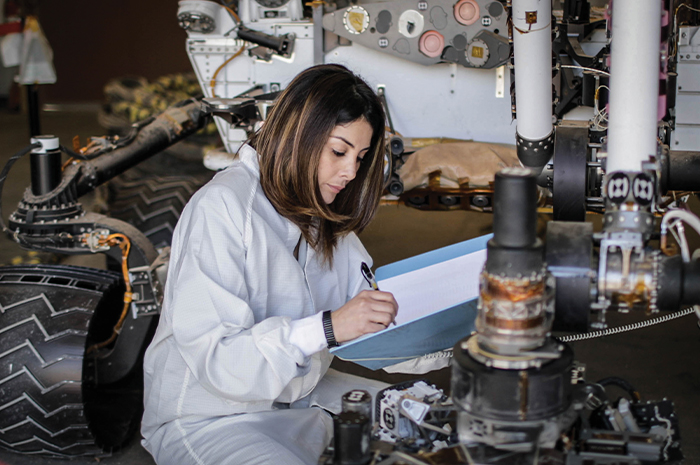
A Space Odyssey
From stargazing in Colombia to building robotics for Mars—an aerospace engineer has circled back to her beginnings.
By Yara Palin
NASA’s Perseverance rover touched down on the surface of Mars in early 2021. It had traveled through 300 million miles of space over about seven months. But the journey of mission flight director Diana Trujillo had taken even longer.
As a child, Trujillo would look at the sky in her hometown of Cali, Colombia, and wonder if humans were truly alone in the universe. When she was seventeen years old, she immigrated to the United States, landing alone in Miami with $300 in her pocket.
Housecleaning jobs allowed Trujillo to support herself, and English lessons opened up educational opportunities starting with community college. She eventually earned an aerospace engineering degree from the University of Maryland (UMD); an internship with NASA Academy, an intensive leadership training and research program, followed. When the phone rang with the news that she had been selected, Trujillo put it on mute and ran around her house. Her mother also reacted in disbelief. “She was like, ‘NASA? Like N-A-S-A NASA? That NASA?’” the engineer says.
Starting at the space agency in 2007, Trujillo has worked in a number of roles, including as the engineering division’s deputy team chief for Mars Curiosity, NASA’s largest rover that launched in November 2011.
At the Jet Propulsion Lab in Pasadena, California, the Perseverance flight director led the team that designed and built the more recent rover’s seven-foot robotic arm. It incorporates shoulder, elbow, and wrist “joints” enabled by tiny motors and is topped by a turret “hand” with tools. The rover will use a drill with interchangeable bits to extract rock core samples; scientific cameras; and mineral and chemical analyzers to seek evidence of life.
Although her work has been an important part of the Perseverance mission, the engineer is humble about her contributions. It is the classic engineering teamwork that made this extraordinary mission possible, Trujillo explains, emphasizing the ingenuity and capability of the entire Perseverance team in enabling the Mars exploration.
While she hopes to reach space herself one day, Trujillo has found another sense of purpose in motivating members of underrepresented groups to pursue STEM and aeronautics. She herself almost didn’t. In line to declare her major at the University of Florida, which she attended prior to transferring to UMD, she picked aerospace engineering after coming across a magazine containing images of female astronauts. Their backgrounds were either in medicine or engineering. “I thought, ‘sounds like it’s one of those. I’ll go for aerospace,’” she recalls. Her resolve faltered a bit, however, when she realized that she was one of the few Hispanic women in line.
During the NASA internship, Trujillo was the only Hispanic person in her class. Throughout her career, she has consistently found herself the only Latina in sight.
According to the National Science Foundation, in 2019 Hispanics held only 8.3% of engineering jobs in the United States, with Hispanic women comprising only 1.6%. Trujillo believes the more visible she and other role models are, the more families will encourage young Latinas to pursue STEM—when traditionally they have been pushed into careers seen as more “feminine.” Growing up, she never heard, “mija, you can be an astronomer” or “mija, you can be an astronaut.”
The aerospace engineer, who hosted NASA’s first-ever Spanish-language broadcast for a planetary landing with Perseverance, is confident that broadening inclusion in STEM can advance the goals of space exploration. “It feels like we’re rising up to the occasion, as humans, to do something bigger than us,” she says. “If we find that there was life on the surface of Mars in the past, we’re going to do it together as humans.” And now, when Trujillo looks at the sky, she knows she is working toward the answers she once sought.
Yara Palin is assistant editor of Prism.
© ASA/JPL-Caltech